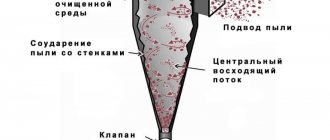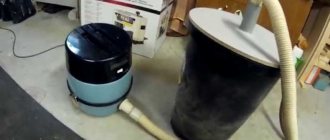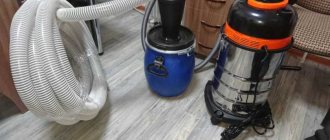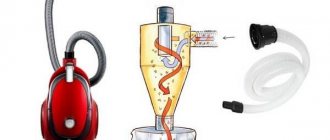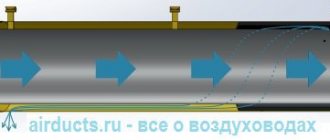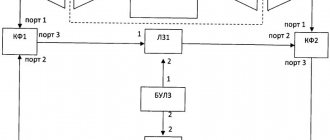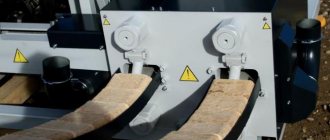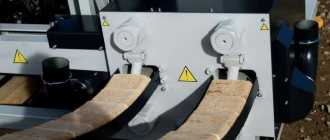The manufacturer of gas cleaning and dust collection equipment "PZGO" welcomes its Visitors and offers for a detailed consideration of the features and principles of operation, as well as for the production and local implementation of such type of equipment as an industrial cyclone for sawdust, shavings, dust and other by-products of processing wood, metal, polymers and other materials.
For more than three decades, on our own full-cycle lines, we have been manufacturing and implementing effective, reliable, compact, modern and affordable cyclone dust collectors, which, independently or as part of multi-stage installations, serve reliably at more than 200 machining sites in the Russian Federation, the CIS, Asia and Europe.
Get advice or ask a question
Where is it used?
Removing small waste from machine tools at any enterprise is an important organizational task. Woodworking is one of the industries with the maximum equipment capacity and corresponding amount of waste. If the process of constant waste disposal is not properly organized, labor productivity drops sharply due to the need to constantly interrupt for cleaning the premises.
A fan for removing sawdust and shavings turned out to be the optimal solution to the problem, operating with virtually no human intervention and completely eliminating the need for enterprise workers to carry stretchers with waste.
The main area of application is carpentry or woodworking enterprises, furniture production and other workshops that process solid wood. In addition, a dust fan for sawdust has also proven useful at other enterprises that work with light, fine-grained bulk materials that need to be transported or removed from the premises. An example of such use would be grain elevators, enterprises producing cereals, etc.
Bag filters
The second effective solution for industrial aspiration. The bag filter is a series of non-woven polyester bags with internal frames.
Principle of operation
- The fan directs flows of contaminated air through the bags.
- Due to the properties of the hose material, wood dust settles on the inner surface of the hoses.
- The air passes through the material and, completely purified, returns to the workshop.
- At the bottom of the sleeves there are boxes or bins where dust falls. They need to be emptied periodically.
- As particles settle inside the filter, its effectiveness decreases. Therefore, an auxiliary mechanism is used - automatic shaking or blowing through the bags - so that the sawdust falls down, freeing the inner surface of the filter.
The main advantage of bag filters is that they retain up to 99% of fine particles, and the air mass is suitable for return back to the workshop. Thanks to this solution, there is no heat loss.
The disadvantages of bag filters include the relatively quick filling of the lower bunkers.
What are they?
Dust fans belong to the group of radial or centrifugal devices. They are capable of creating sufficient pressure to move mass through the duct system. Centrifugal designs work equally well for both discharge and suction, which increases their capabilities, allowing the direction of flow to be changed if necessary.
This distinguishes them from axial fans, which are capable of high performance, but do not have the ability to provide high pressure. The air flow from axial structures cannot overcome the aerodynamic resistance of the air ducts, while simultaneously moving certain masses of material.
Radial fans vary in the amount of pressure they create. High-pressure dust fans for sawdust or shavings are needed to work on long and branched air duct systems. Medium and low pressure fans are used in appropriate conditions and are selected based on calculated data.
Expert opinion
Online ventilation store "Runicom"
The difference between dust fans and other centrifugal devices is the design of the impeller . Most samples have 16, 24 or more blades, but on dust fans there are much fewer - usually 5, 6 or 7, on larger numbers there may be 9.
Overview of species
The main purpose of chip ejectors is to eliminate waste and clean the air in the room. Currently, you can find several types of this type of equipment, for example, with and without floor cleaning.
Portable
Chip ejectors of this type are small-sized products that can be quickly installed and disassembled. The portable unit is lightweight, so it can be placed on a table, making it easy and convenient to use. It is recommended to be used where the use of other types of chip suction is impossible. In addition to the above advantages, such devices have the following disadvantages:
- low power;
- low level of productivity;
- low quality of waste disposal.
Mobile
The location of mobile devices for dust removal should be concentrated directly near the machines. To move the mobile unit, you will need to use a cart or similar device. A chip ejector of this type can be used for several machines; for this purpose, they are used alternately and after a certain time.
Stationary
The device for collecting chips after the woodworking procedure is mounted in one permanent place. Its transfer to another location is impossible. The advantages of a stationary device are considered to be good power, performance and reliability. The only downside of the unit is the lack of mobility.
How to choose?
The selection of the most suitable fan is made according to the following criteria:
- performance . An indicator that determines the volume of air flow created by a fan per unit of time.
- pressure . This metric is more important than performance because moving materials requires airflow with sufficient momentum.
Each brand of fans has its own range of standard sizes, determined by the fan number. The number has its own meaning - it indicates the diameter of the impeller, expressed in decimeters.
For example, No. 5 means that the impeller has a diameter of 50 cm . All other proportions, design indicators and other features remain the same. The only difference may be the number of blades, since on larger devices the circumference is much larger and allows you to increase the number of blades without compromising the operation of the installation.
Selecting the appropriate fan is based on the size of the system. The parameters of the device are directly related to its dimensions, so selection is made by comparing the calculated data with the performance characteristics of a particular fan number.
An advertising campaign will help you find more clients. Experts advise creating a company website and groups on popular social networks. At the same time, advertisements are placed on thematic Internet sites and forums. Another direction of the advertising campaign is the printing of flyers and leaflets that are distributed in crowded places, near new buildings. Participation in thematic exhibitions and fairs is mandatory, where manufacturers exhibit samples of their work. As marketing activities, you can consider additional free services, for example, delivery of ordered products to the address, assembly of furniture. As part of your marketing strategy, you should pay attention to the positioning of products. For example, to focus the attention of potential buyers on the quality of raw materials and the finished product: “We use solid oak and teak for production,” “We will develop a design taking into account the interior concept.”
Features of operation and maintenance
Radial fans are highly reliable and require virtually no maintenance. Depending on the location conditions, the housing is periodically cleaned from dust and dirt, painted and other cosmetic procedures are performed. For installations located outdoors, periodic lubrication of the motor bearings or the individual impeller drive shaft is recommended.
Expert opinion
Online ventilation store "Runicom"
The main problems encountered during operation are the formation of congestion due to the presence of sharp turns or forks in the air ducts. The solution to the problem is to install channels without sharp turns or changes in cross-sectional area, as well as install gratings with large cells to filter out too large fragments of material.
To eliminate the resulting blockages, inspection hatches are installed on the air ducts, and special removable panels are made at the inlet and outlet openings of the fans, allowing access to the impeller for cleaning and removing foreign objects.
The best thicknessing machines for wood in terms of price-quality ratio for 2022
Budget doesn't mean bad: a selection of cheap but reliable tools.
BELMASH P2200M 2.2 kW
BELMASH P2200M 2.2 kW
BELMASH P2200M is a modified version of BELMASH P1500M. The product is based on a cast base with holes for mounting on a workbench; there are also supporting racks and a granite work table. The equipment includes folding extensions with a stiffening rib.
Characteristics:
- single-phase motor, double insulation, power - 2200 W;
- table - 330 mm;
- width - 240 mm;
- workpiece width - 330 mm;
- depth - 2.4 mm;
- feed - 7 m/min;
- height - 152 mm;
- knives - 3.
Pros:
- the power switch lock helps to avoid unauthorized starts;
- planing indicator with display of the height of one pass and adjustment when moving the working platform;
- broaching rollers allow the return of the pre-processed workpiece.
Minuses:
- lack of a spare set of knives.
Users appreciate the power of the engine, the presence of three knives and the rigidity of the granite counter table. In their experience, the model can be used straight out of the box. The engine is smoother than in JET 12.
Makita 2012NB 1.65 kW
Makita 2012NB 1.65 kW
A simple and reliable surface thicknesser from a company that has long been replenished with top brands. All you need to do is turn it on and work—no extra manipulations required.
Characteristics:
- table - 771 mm;
- width - 304 mm;
- depth - 3 mm;
- movement speed - 8.5 m/min;
- power consumption - 1.65 kW;
- chain transmission;
- height - 155 mm;
- two knives.
Pros:
- can be used without using a vacuum cleaner, and will be relatively clean;
- high quality of the final product;
- easy replacement of knives;
- high-quality assembly at low cost.
There are no cons.
An excellent working tool, easy to maintain and repair, which, by the way, is rare - user comment.
DEWALT DW735, 1800 W
DEWALT DW735, 1800 W
A device with an automatic protection system that turns off the power supply during sudden voltage surges. The motor is also protected against overload. The machine can be mounted on a workbench through a special set of lugs made in the table. The structure stands on four stainless steel posts, which absorb operating vibration and ensure smooth and even movement of the cutting element. The quality of processing is ensured by three knives. The strength of the casing allows you to protect the operator from quite serious injuries.
Characteristics:
- width - 330 mm;
- depth - 3 mm;
- advance speed - 7 m/min;
- height - 152 mm;
- three knives;
- smooth start.
Pros:
- perfectly smooth workpiece surface;
- compactness and attractive design;
- high-strength die-cast aluminum housing;
- safe use thanks to automation.
Minuses:
- quite loud noise;
- fixed size.
Perhaps, one of the outstanding mobile versions of a surface planer, judging by the totality of the device’s qualities. Mobility can be called conditional: when carrying it, it is better to ask for help. If desired, you can purchase a spiral shaft for hard rock.
Recommended Models
Dust fans VCP 7-40 priced from 14,238 rubles.
- -15%
Dust fans VCP 7-40VTSP 7-40 No. 10 11 kW 750 rpm
out of 5
366 250 ₽ 311 312 ₽Select...Add to Wishlist
- -15%
Dust fans VCP 7-40
VTSP 7-40 No. 10 22 kW 1000 rpm
out of 5
400 590 ₽ 340 500 ₽Select...Add to Wishlist
- -15%
Dust fans VCP 7-40
VCP 7-40 No. 10 75 kW 1500 rpm
out of 5
469 020 ₽ 398 667 ₽Select...Add to Wishlist
- -29%
Dust fans VCP 7-40
VCP 7-40 No. 12.5 30 kW 750 rpm
out of 5
711 130 ₽ 504 460 ₽Select...Add to Wishlist
A special feature of radial fans is the presence of a large number of models that are complete analogues of each other . This is due to the lack of significant diversity in device design.
Any deviations from the standards will only worsen the performance of the fans, so no changes are made. In addition, there are no special requirements for marking fan models; there is only a link to the size of the air ducts and a breakdown by standard sizes (numbers). This has become the reason that each fan model has a large number of analogues, which causes considerable confusion.
For example, the dust fan VCP 7-40 has analogues:
- VR 140-40
- VR 100-45
- GRP 115-45
- VR 6-45
Expert opinion
Online ventilation store "Runicom"
Important! Considering that there is no fundamental difference between them, the differences are only external (some models are painted, others are made of galvanized steel) and cannot affect the operation of the device, the choice should be made not by model, but by characteristics , compatibility with the air duct system, number and other operational parameters.
To the carpentry shop
The machine section of a carpentry shop produces a huge amount of sawdust and shavings . Moving these materials does not require significant effort, but in large production volumes it may. It is difficult to name any chip fan as the most preferable design option without reference to the volume and composition of the material being moved.
Typically, fans of the VCP 7-40 type or their analogues are used. You can use products from foreign manufacturers, for example, the Polish company WALTER or other equipment manufacturers. There is no significant difference in quality and performance, so it is customary to be guided by considerations of economy.
For furniture production
The specificity of furniture production is the presence of waste from sawing laminated chipboard, MDF and other similar materials. There is also a lot of waste from grinding, milling, and drilling. Most of the material to be removed is a type of sawdust with a high weight due to the adhesive contained in the sheet materials. To remove such waste, a fan for sawdust is required, capable of providing transportation conditions and lifting to the height required by the operating conditions of the cyclone.
Any dust fan of appropriate power and performance can transport the material. All variants, analogues and modifications of the VR 6-45 device and similar models are suitable.
The main task in this case is not transportation, but to ensure tightness and the absence of pollution of the surrounding air by small particles of wood boards with chemical impurities. Therefore, high-quality filtration units must be connected in parallel to aspiration systems to clean the flow from dust and harmful impurities. This complicates maintenance and requires the purchase of additional equipment, but the fines for environmental pollution are much higher.
Aspiration systems for metalworking based on cyclones
During - and after - the Industrial Revolution, metal became widespread. The era of heavy industry began, unthinkable without mechanical processing of ferrous and non-ferrous metals, cast iron, and alloys.
This prompted inventors and scientists to develop, among other things, gas purification, dust collection and smoke purification equipment. During the industrial boom, in 1885, American inventor and industrialist John M. Finch patented the first cyclone separator.
The aspiration and ventilation of metal chips and dust is generally similar to similar processes related to the extraction and removal of wood waste, but with some differences.
See the completed plant project: collecting grinding dust and GOI paste in a foam scrubber.
Metal is much harder and, as a result, abrasive, which dictates the corresponding requirements for the wear resistance of structural materials from which cyclones for metalworking are made.
Aluminum chip aspiration system
Among other things, the greater weight of metal shavings than wood shavings usually requires the installation of slightly more powerful pressure fans, which remove waste from the place of its formation.
"PZGO" has a modern production infrastructure. For many years we have been working with a wide range of structural materials, including high-strength steels and wear-resistant alloys. Manufacturing a cyclone filter for abrasive dust is not a problem for us.
Adviсe
First of all, you need to know some of the intricacies of labeling. For example, fan No. 6.3 has an impeller diameter of 63 cm rather than 60 cm.
The most common fan model for small and medium-sized workshops is considered to be VRP 115-45 No. 6.3 or its analogues . At the same time, it should not be used without preliminary calculations, since operating conditions and the length of air ducts (sleeves) can significantly change the requirements for the fan.
Expert opinion
Online ventilation store "Runicom"
Dust installations experience strong vibration . The reason for this lies in the composition of the flow - the presence of a large amount of solid particles creates significant loads on the hoses, causing vibration. This forces you to constantly monitor the condition of the fan housing. Sooner or later, metal fatigue appears and cracks appear. If you don't touch them, the case may simply tear in half. The solution to the problem is welding along the fault line , but this measure is short-lived. The metal at the welding site is stressed, vibration loads quickly form a new crack, so after repair the body must be monitored even more carefully. If the problem cannot be resolved, the fan will need to be replaced.
DIY ventilation: action plan
Woodworking machines for the home workshop: drawings, instructions and photo examples
To design a ventilation system yourself, you will have to perform a number of actions. It's easier if the sequence is known.
Preparatory work
Collecting information and basic calculations - this is where the independent creation of a ventilation project begins.
- Calculate the exchange rate in the entire house/apartment. It depends on the volume of the premises (you need to calculate the cubic capacity of each room), their purpose, and the number of residents. According to sanitary standards, the air in residential premises must be changed once per hour, in technical premises (kitchen/bathroom/toilet) - at least three times per hour. There are different standards for boiler houses and they must be taken into account (depending on the type of heating). Adding up all the numbers, we get the required system performance, according to which the cross-section of the exhaust air duct is calculated, and the performance of the ventilation equipment is selected.
- Draw a diagram of the movement of air flows. In this case, you immediately have to estimate the position of the supply and exhaust channels.
- Draw a diagram of the air ducts. No dimensions or details yet, just adhering to the rules and trying to fit into the system without complicating the design too much. This is where everything is complicated, since the air ducts can only be hidden behind a suspended or suspended ceiling. Otherwise they will be open.
Preliminary data is ready. Take some time to think about where and what devices should be located.
Parameter calculations and detailing
When all the issues regarding the scheme have been resolved, it has taken its final form, we proceed to detailing. First, there are also calculations, then you have to look for the components of the system, decide which company to use the equipment and reduce the budget.
- Calculate the cross-section of the air ducts based on the exchange rate, the volume of the room and the speed of “silent” air movement. Otherwise it will be impossible to live.
- Add dimensions to the diagram (can be redrawn).
- Carry out detailing. That is, make a list of necessary system elements indicating the type and cross-section.
- Calculate the resistance of each section of the system, select fans (according to the operating point in the characteristic, taking into account the obtained system resistance). Take into account the noise level from the fan operation, take measures to reduce it (select a low-noise model).
- Calculate the cost of system components. Try to combine “cash” with desires. Here you have to change components several times, moving from what you want to what is real.
- We draw a final design with full detail. We must also remember about the units for the passage of ventilation ducts through the walls/ceiling/roof, consumables and insulating materials, ventilation grilles and diffusers, fasteners and all other “little things” that add up to a decent amount.
Installation and configuration
“All that remains” is to find, buy, install. Little has been written, but it will take a lot of effort, time, and nerves to implement this point. Only after this can we say that the DIY ventilation is completely ready.
But that’s not all. Self-made ventilation must be started and adjusted. This is also not the easiest process to achieve coordinated operation of the system as a whole. Then, during operation, reconfiguration has to be done frequently. When the season changes, the number of residents changes, weather conditions change. In general, adjusting the ventilation system is another responsibility of the home owner.
Such holes on the facade are left by supply valves/recuperators
By the way, we advise you to think about it. Do-it-yourself ventilation (meaning installation) will cost less, but it requires more knowledge and time. Knowledge can be gained, but if there is a lack of time, you will have to look for and hire performers, then accept their work.
The best planer-thicknesser machines
There is no need to choose between the principles - you can combine them in one product, obtaining a budget-friendly and reliable tool.
CALIBER SSR-1600 1.6 kW
CALIBER SSR-1600 1.6 kW
The best model in the price-quality category. A simple and unpretentious surface thicknesser from a domestic manufacturer.
Characteristics:
- table length - 268 mm;
- table width - 208 mm;
- workpiece width - 204 mm;
- the maximum thicknessing depth parameter is 2 mm;
- workpiece feed - 6 m/min;
- maximum workpiece height - 120 mm;
- two cutting edges.
Pros:
- no initial setup required;
- cuts exactly to size.
There are no cons.
The product is one of those tools that require minimal modification with your own hands, after which it can serve for years.
BELMASH SDR-2200
BELMASH SDR-2200
This is a reliable model, which is designed for planing and thicknessing. All operations are performed quickly and give the workpiece the desired shape and size. Feeding is carried out manually, which is convenient and safe. The design is made in such a way that it makes it possible to easily move the product without special tools. The device has a wide table and a convenient start button.
Characteristics:
- equipped with a single-phase electric motor with a power of 2.2 kW;
- the shafts rotate at a speed of 7700 rpm;
- depth of planing and contouring - 3 mm, feed - 6 m/min;
- the table has dimensions of 425x260 mm, which will make it easier to work with large workpieces.
Pros:
- the plane shafts do not leave marks on the wood, and the sliding bushings have a long service life;
- the guide allows you to chamfer at an angle of 45 degrees along the entire length of the workpiece;
- The rip fence can be installed on both sides of the table.
Minuses:
- “extra functions” - difficult to figure out when using at home.
Owners complain about the need to adjust the legs after purchase.
The best thickness planers for wood with two knives
Double speed with two knives - now not only in the photo, but also on sale at an affordable price.
CALIBER RR-2000/330/160 2 kW
CALIBER RR-2000/330/160 2 kW
High-quality machine assembled in China. The product is intended exclusively for surface treatment of softwood elements. Planing is performed according to the size specified by the operator. For greater convenience, the machine is equipped with a magnetic starter, which prevents accidental starting of the machine and increases operating safety.
Characteristics:
- thicknessing table length - 290 mm;
- width - 330 mm;
- depth - 3 mm;
- the workpiece is fed at a speed of 6 m/min;
- maximum height - 160 mm;
- two knives.
Pros:
- magnetic switch;
- small dimensions;
- reliability;
- ease of operation;
- durability;
- two sharp tool steel blades;
- power.
Minuses:
- there is no connection for the vacuum cleaner.
Poor shaft traction, slippage and the need for manual assistance are the main consumer complaints.
RedVerg RD-WP330 2 kW
RedVerg RD-WP330 2 kW
Designed for planing wooden blanks and giving them certain sizes. Knives made from high-quality cutting steel will precisely cut your object and give it the desired shape. Adjustment of the operating parameters of the equipment is carried out by manipulating the planing shaft. The RedVerg thicknesser will perform well both in a private workshop and on a construction site.
- maximum width - 330 mm;
- processing depth - 3 mm;
- feed of workpieces - 6 m/min;
- maximum height of workpieces - 160 mm;
- number of knives - 2.
Pros:
- relatively low cost;
- the unit for lowering and raising the planing element is equipped with metal gears, unlike more expensive analogues with plastic elements;
- The motor has a power reserve when processing wet boards.
Minuses:
- noise;
- need to adjust tables.
According to reviews, the belt quickly fails; when replaced with a new one, the noise disappears, but not for long. The lower part of the frame is scratchy and can be easily damaged. Poor chip removal.
The best thickness planers for wood with belt drive
BISON SR-330-1800 1.8 kW
ZUBR SR-330-1800 1.8 kW
Good build quality and configuration for reasonable money.
Characteristics:
- table length - 307 mm;
- thicknesser width - 290 mm;
- workpiece width - 305 mm;
- thicknessing - 3 mm;
- feed - 6 m/min;
- two knives.
Pros:
- By removing the two plastic height stops in front of the guide, you can get +5 cm of lift height.
Minuses:
- low quality of components;
- dry bearings out of the box.
The machine corresponds to the description, at least for personal use. Not suitable for commercial use - too little performance.
Encore Corvette 21 1.5 kW
Encore Corvette 21 1.5 kW
Thicknessing machine "Corvette 21" is designed for processing workpieces in thickness dimensions.
Characteristics:
- table length - 318 mm;
- width - 295 mm;
- workpiece - 318 mm;
- depth - 2.5 mm;
- speed - 8 m/min;
- Belting;
- workpiece height - 153 mm;
- two knives.
Pros:
- powerful motor with thermal relay for overload protection;
- belt drive prevents engine overload;
- there is a planing depth limiter for wide parts to protect the machine;
- keys to protect against unauthorized activation;
- folding (front, rear) table extensions with an additional roller;
- upper rollers to facilitate the return of the finished part to the planing zone;
- set included.
Minuses:
- no chip removal.
Buyer's opinion: 100% efficiency of the machine, no complaints, justified my purchase (for a mini-workshop).
Encore Corvette 22-330 1.5 kW
Encore Corvette 22-330 1.5 kW
Analogous to the previous version.
Characteristics:
- length - 330 mm;
- width - 235 mm;
- workpiece width - 330 mm;
- thicknessing - 2.4 mm;
- feed of workpieces - 7 m/min;
- Belting;
- shaft with two knives.
Pros:
- the machine is equipped with an electromagnetic starter;
- for safe operation the machine is equipped with anti-kickbacks;
- planing depth limiter for narrow workpieces to protect the machine from overload;
- motor thermal protection;
- rollers are installed on the upper rows to facilitate the return of the workpiece to the receiving table;
- pipe for connecting a vacuum cleaner;
- convenient planing depth indicator;
- the workpiece is fed through automatic feeding, which is carried out by two rubberized rollers;
- knife with double-sided sharpening.
There are no cons.
